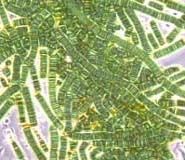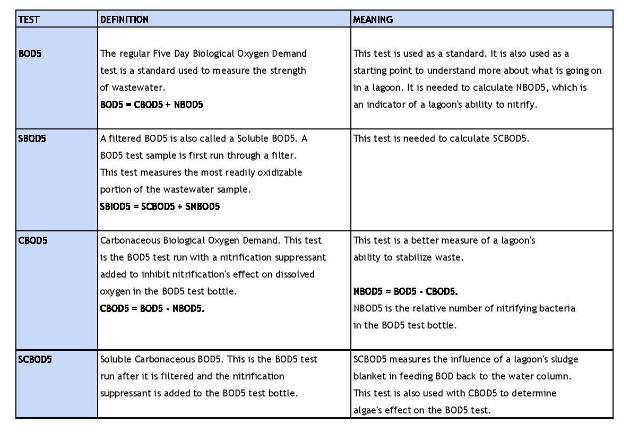
The BOD5 test may be the standard—but is it a reliable reflection of the quality of treatment in your lagoon? In this article we will discuss the BOD5 test and speak to the potential problems with it, such as the effect nitrifying bacteria in the sample can have on BOD test results, especially in aerated lagoons. We’ll also describe the various types of wastewater lagoon BOD tests and their value in diagnosing lagoon issues.
Why is BOD5 tested?
The BOD5 test of Biological or Biochemical Oxygen Demand is a standard test performed by wastewater facilities to demonstrate compliance with permit requirements. Performed under controlled conditions, it measures the amount of oxygen used by the bacteria to break down the organic waste in the sample over a five-day period. It’s an indirect measurement—like trying to estimate how many people attended a party by inventorying the buffet before and after.
The BOD5 test is intended to indicate how much oxygen the organisms in the effluent could potentially deplete from receiving waterways. Effluent with too much undigested waste will consume the oxygen from the receiving stream and degrade its quality, potentially choking out aquatic life. Facilities need to reduce BOD to permitted levels before wastewater can be discharged to prevent this potential damage to the local ecosystem.
Despite its general acceptance as an indicator of treatment quality, the lagoon BOD test has some flaws:
It's Slow
It’s speculated that the origin of the five-day incubation period for BOD testing is 19th century England, where five days reflected the amount of time it took for sewage to reach the sea once dumped into the Thames River. This seems a really long time to wait nowadays, when we value immediacy. A prepared sample is incubated for five days, providing the lagoon operator with a snapshot of the lagoon’s conditions—five days earlier. By the time the results are in, the problem wastewater may have already been discharged. In a recent article, Pros and Cons of the Biochemical Oxygen Demand Test, TPO magazine called the BOD5 test “[an] outdated, outmoded and perpetually tardy analysis.”
It's Tricky
There are many factors that can cause inaccurate BOD test results: the cleanliness of the bottles and samples lines, the pH of the sample, the quality and temperature of the dilution water, the viability of the seeded bacteria—even barometric pressure. It’s important that testing procedures are conscientious, consistent, and conform to standard methods to ensure accuracy.
Even with the best testing and lab techniques, other factors can skew BOD5 test results:
The nitrifier problem
BOD is defined as the amount of oxygen necessary to stabilize biodegradable organic matter in wastewater. BOD has two components: carbonaceous oxygen demand and nitrogenous oxygen demand. The carbonaceous oxygen demand, or CBOD, measures the amount of oxygen the bacteria in the sample need to biologically stabilize the organic matter and generally indicates the strength of the waste stream.
The nitrogenous oxygen demand, or NBOD, is a measure of the amount of oxygen any nitrifying bacteria would consume in the process of converting inorganic forms of ammonia and nitrogen to nitrite and nitrate. NBOD doesn’t tell you how much ammonia or nitrogen are in the wastewater, but rather the relative quantity of nitrifying bacteria in the sample.
Any nitrifying bacteria in the sample will exert an oxygen demand, implying that there are higher levels of organic waste in the lagoon than there actually are. It has been estimated that as much as 60 percent of BOD compliance violations were actually due to nitrifiers in the BOD sample, leading to unnecessary and expensive plant upgrades.

This is especially an issue in aerated lagoons. It’s been well established for decades that the nitrogenous oxygen demand skews the results of BOD5 testing in aerated lagoons. The late Linvil Rich, the founder of Clemson University’s Department of Environmental Engineering and Science and a pioneer in lagoon technology, discusses this in detail in his technical bulletins on aerated lagoons.
In his Technical Note Number 1, Effluent BOD5—A Misleading Parameter for the Performance of Aerated Lagoons Treating Municipal Wastewaters, Rich stated: “…the argument that the test provides insight on the impact the effluent will have on the receiving water cannot be defended.” In other words, where aerated lagoons are concerned, the BOD test is not reliable and doesn’t tell much about the actual effluent quality.
The CBOD5 test
In order to get a more accurate reading of BOD, especially in aerated lagoons, it’s necessary to add a nitrification suppressant to inhibit the nitrifiers’ effect on dissolved oxygen levels. This CBOD5 test isolates the carbonaceous component of the wastewater without the influence of nitrifying bacteria. While it’s more accurate, it is more expensive. But with permission from the regulating agency, discharge permits can be amended to substitute CBOD5 effluent limits for BOD5 in aerated lagoons.
More tests, more insight
From Steve Harris’s Wastewater Lagoon Troubleshooting, An Operator’s Guide, adding a few extra procedures to the standard BOD5 test can reveal a lot about the health of a lagoon.

These variations on the standard BOD5 test can give you insight into your lagoon’s performance by isolating the effects of algae, nitrifiers, and sludge on your effluent quality.
Still the standard
The BOD5 test has been the standard for decades, so it’s unlikely to go anywhere. However, by understanding its shortcomings—especially in aerated lagoons—the operator can get a true picture of the quality of treatment.
